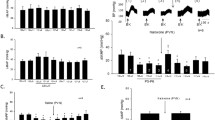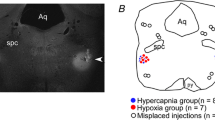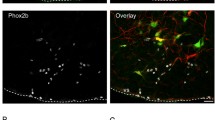Abstract.
To investigate whether impulses from chemoreceptors influence the release of catecholamines in the hypothalamus and the locus coeruleus, the two brain areas were superfused simultaneously and bilaterally with artificial cerebrospinal fluid through push-pull cannulae. The release of catecholamines was determined in the superfusate before and during chemoreceptor stimulation by bicarbonate solution saturated with carbon dioxide (CO2-NaHCO3) or KCN. Experiments were carried out on intact cats after carotid body denervation (CD).
Intracarotid infusion of CO2-NaHCO3 increased arterial blood pressure and enhanced the release of noradrenaline but not dopamine in the posterior hypothalamus and the locus coeruleus. Following CD, the enhancing effect of CO2-NaHCO3 on the noradrenaline release in the posterior hypothalamus was abolished, while the effect on blood pressure was slightly enhanced. CD reversed the NaHCO3-induced release of noradrenaline in the locus coeruleus to a decreased noradrenaline outflow. Intracarotid infusion of KCN led to a fall in blood pressure. KCN increased the release rates of noradrenaline and, to a lesser extent, that of dopamine in the posterior hypothalamus, as well as the release of noradrenaline in the locus coeruleus. CD abolished the KCN-induced fall of blood pressure and the increased release of noradrenaline and dopamine in the posterior hypothalamus. Similar to CO2-NaHCO3, the enhancing effect of KCN on the noradrenaline release in the locus coeruleus was reversed following CD to a reduced noradrenaline outflow. Superfusion of the posterior hypothalamus and the locus coeruleus with KCN did not influence either blood pressure or the release rates of noradrenaline and dopamine in these brain areas.
The findings show that impulses originating from chemoreceptors of the carotid body increase the release rates of the catecholamines in the posterior hypothalamus and the locus coeruleus, thus underlining the importance of catecholaminergic neurons of these brain areas in cardiovascular control.
Similar content being viewed by others
Author information
Authors and Affiliations
Additional information
Electronic Publication
Rights and permissions
About this article
Cite this article
Kaehler, S., Singewald, N. & Philippu, A. The release of catecholamines in hypothalamus and locus coeruleus is modulated by peripheral chemoreceptors. Naunyn-Schmiedeberg's Arch Pharmacol 360, 428–434 (1999). https://doi.org/10.1007/s002109900094
Received:
Accepted:
Issue Date:
DOI: https://doi.org/10.1007/s002109900094




